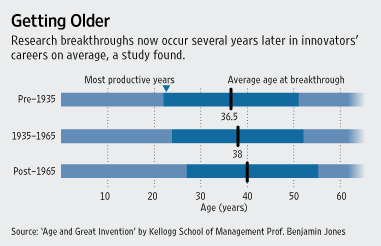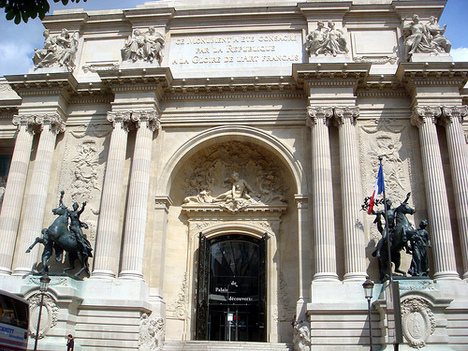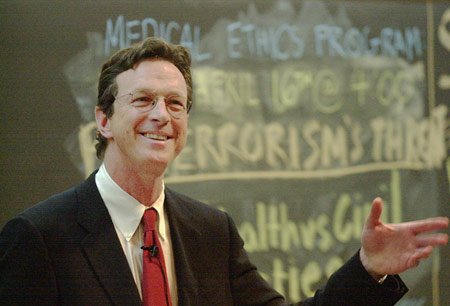 Source of graph: online version of the WSJ article quoted and cited below.
Source of graph: online version of the WSJ article quoted and cited below.
(p. B5) A particularly stark view of age-related constraints on researchers’ work comes from Benjamin Jones, an associate professor at Northwestern University’s Kellogg School of Management. He examined biographical data over the past century for more than 700 Nobel laureates and renowned inventors.
His conclusion: “Innovators are productive over a narrowing span of their life cycle.” In the early 20th century, he found, researchers at the times of their greatest contributions averaged slightly more than 36 years old. In recent decades, innovation before the age of 30 became increasing rare, with the peak age of contribution rising toward age 40. Meanwhile, the frequency of key contributions has consistently diminished by researchers in their early or mid-50s.
Occasionally, Mr. Jones says, booming new fields “permit easier access to the frontier, allowing people to make contributions at younger ages.” That could account for the relative youth of Internet innovators, such as Netscape Communications Corp. founder Marc Andreessen and Messrs. Page and Brin. But “when the revolution is over,” Mr. Jones finds, “ages rise.”
Unwilling to see researchers at peak productivity for only a small part of their careers, tech companies are fighting back in a variety of ways. At microchip maker Texas Instruments Inc., in Dallas, executives are pairing up recent college graduates and other fresh research hires with experienced mentors, called “craftsmen,” for intensive training and coaching.
This system means that new design engineers can become fully effective in three or four years, instead of five to seven, says Taylor Efland, chief technologist for TI’s analog chip business. Analog chips are used in power management, data conversion and amplification.
At Sun Microsystems Inc., teams of younger and older researchers are common. That can help everyone’s productivity, says Greg Papadopoulos, chief technology officer for the Santa Clara, Calif., computer maker. Younger team members provide energy and optimism; veterans provide a savvier sense of what problems to tackle.
For the full story, see:
GEORGE ANDERS. “THEORY & PRACTICE; Companies Try to Extend Researchers’ Productivity; Teams of Various Ages, Newer Hires Combat Short Spans of Inventing.” The Wall Street Journal (Mon., AUGUST 18, 2008): B5.
A large literature exists on the relationship between age and scientific productivity. I am particularly fond of the following examples:
Diamond, Arthur M., Jr. “Age and the Acceptance of Cliometrics.” The Journal of Economic History 40, no. 4 (December 1980): 838-841.
Diamond, Arthur M., Jr. “An Economic Model of the Life-Cycle Research Productivity of Scientists.” Scientometrics 6, no. 3 (1984): 189-196.
Diamond, Arthur M., Jr. “The Life-Cycle Research Productivity of Mathematicians and Scientists.” The Journal of Gerontology 41, no. 4 (July 1986): 520-525.
Diamond, Arthur M., Jr. “An Optimal Control Model of the Life-Cycle Research Productivity of Scientists.” Scientometrics 11, nos. 3-4 (1987): 247-249.
Diamond, Arthur M., Jr. “The Polywater Episode and the Appraisal of Theories.” In A. Donovan, L. Laudan and R. Laudan, eds., Scrutinizing Science: Empirical Studies of Scientific Change. Dordrecht, Holland: Kluwer Academic Publishers, 1988, 181-198.
Hull, David L., Peter D. Tessner and Arthur M. Diamond, Jr. “Planck’s Principle: Do Younger Scientists Accept New Scientific Ideas with Greater Alacrity than Older Scientists?” Science 202 (November 17, 1978): 717-723.




